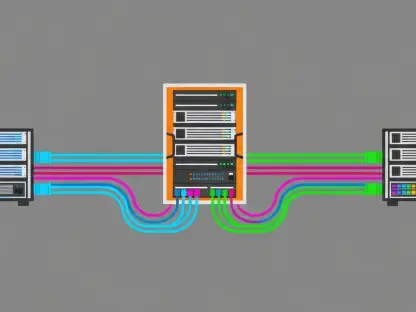In an era where technological advancements unfold at an unprecedented pace, artificial intelligence (AI) stands out as both a revolutionary ally and a daunting adversary in the realm of fraud prevention, while the alarming surge of AI-driven threats, including deepfake social engineering and synthetic identity fraud, sends shockwaves through the global community of anti-fraud professionals. A comprehensive survey conducted by the Association of Certified Fraud Examiners (ACFE) and SAS, a leader in data and AI solutions, reveals a troubling reality: these sophisticated schemes are not only accelerating but often surpassing the defensive capabilities of many organizations. Highlighted during International Fraud Awareness Week, this issue demands urgent attention as fraudsters exploit AI to craft deceptions with startling speed and precision, challenging the very foundation of trust in digital systems.
While the threat looms large, there is a glimmer of hope in how AI is also being harnessed to bolster defenses across various sectors. From banking to insurance to public benefits programs, innovative applications of machine learning and advanced analytics are helping to detect and prevent fraudulent activities more effectively than ever before. Yet, a significant gap in preparedness persists, with fewer than one in ten anti-fraud experts feeling equipped to tackle these emerging challenges. This stark statistic underscores the critical need for enhanced education, resources, and collaboration to keep pace with the evolving landscape of deception. As the stakes continue to rise, with billions of dollars lost annually to fraud, the question remains whether current efforts can match the rapid sophistication of AI-powered threats.
The Escalating Challenge of AI-Driven Deception
Sobering Data on Rising Threats
The scale and speed of AI-driven fraud have become a pressing concern, as evidenced by the latest findings from the ACFE-SAS survey. A staggering 77% of anti-fraud professionals report having observed a marked increase in deepfake social engineering attacks over the past two years, a trend that shows no signs of slowing. Even more concerning, 83% of these experts predict a moderate to significant rise in such schemes over the next few years, signaling a future where distinguishing reality from fabrication becomes increasingly difficult. AI’s ability to generate highly convincing fakes in mere seconds, rather than hours or days, has dramatically amplified the potential impact of fraud, affecting everything from individual transactions to large-scale corporate security. This rapid evolution poses a unique challenge, as traditional detection methods struggle to keep up with the technological prowess of modern fraudsters, leaving industries vulnerable to unprecedented risks.
Beyond the numbers, the implications of these statistics are profound, reshaping the very nature of trust in digital interactions. Deepfake technology, for instance, can replicate voices and visuals with eerie accuracy, enabling fraudsters to impersonate executives or loved ones to manipulate victims into divulging sensitive information or transferring funds. The financial toll is immense, with losses mounting into the billions globally each year, but the damage extends to reputational harm and eroded confidence in systems once deemed secure. As AI tools become more accessible, the barrier to executing such schemes lowers, allowing even less-skilled actors to perpetrate complex fraud. This democratization of deception heightens the urgency for organizations to adapt swiftly, ensuring that awareness and countermeasures evolve in tandem with these escalating threats to mitigate their widespread impact.
Gaps in Readiness Among Experts
Amid the rising tide of AI-powered fraud, a critical vulnerability emerges in the form of industry unpreparedness. The ACFE-SAS survey delivers a sobering insight: fewer than 10% of anti-fraud professionals feel adequately equipped to confront the challenges posed by these advanced threats. This glaring deficiency in readiness stems from a combination of limited access to cutting-edge tools, insufficient training on emerging technologies, and a lack of updated protocols to address AI-specific risks. Many organizations still rely on outdated frameworks that fail to account for the speed and sophistication of modern fraud tactics, leaving them exposed to attacks that exploit technological blind spots. This gap not only endangers individual entities but also undermines broader efforts to maintain stability in digital ecosystems where trust is paramount.
The consequences of this unpreparedness are far-reaching, as delays in response can exacerbate financial losses and amplify damage to public confidence. Without a proactive approach to skill development and resource allocation, the industry risks falling further behind as fraudsters continue to innovate. Experts emphasize that bridging this divide requires a concerted effort to integrate AI literacy into training programs and to invest in scalable solutions that can adapt to new threats as they arise. The call for action is clear: organizations must prioritize equipping their teams with the knowledge and technology needed to face AI-driven fraud head-on. Only through such strategic advancements can the industry hope to close the readiness gap and build a resilient defense against the relentless pace of digital deception.
AI’s Dual Role in the Fraud Landscape
Empowering Fraudsters with Advanced Tools
Artificial intelligence has become a potent weapon in the hands of fraudsters, enabling them to execute schemes with a level of sophistication previously unimaginable. Technologies like deepfake social engineering allow malicious actors to create hyper-realistic audio and video content, blurring the lines between truth and fabrication in ways that deceive even the most vigilant individuals. Synthetic identity fraud, another AI-fueled tactic, involves crafting entirely fictitious personas using stolen or fabricated data, often slipping through conventional verification processes. The accessibility of AI tools exacerbates this threat, as platforms that once required specialized expertise are now available to anyone with minimal technical know-how, effectively lowering the entry barrier for criminal activity. This alarming trend erodes trust in digital interactions, as people grow wary of communications that may not be what they seem.
The ripple effects of AI-empowered fraud extend beyond immediate financial losses, striking at the core of societal confidence in technology. When fraudsters can convincingly impersonate trusted figures—be it a corporate leader authorizing a wire transfer or a family member requesting urgent funds—the psychological impact on victims is profound, often leading to hesitation in engaging with legitimate digital platforms. Industries such as banking and e-commerce face heightened scrutiny as customers demand greater assurances of security, pushing companies to rethink how they authenticate identities and transactions. The pervasive nature of these threats, fueled by AI’s ability to scale deception rapidly, underscores the pressing need for countermeasures that can match the ingenuity of fraudsters and restore faith in the systems that underpin modern life.
Harnessing AI for Stronger Defenses
In stark contrast to its role as a tool for deception, AI also offers powerful capabilities to fortify defenses against fraud across multiple sectors. By leveraging advanced analytics and machine learning, organizations can detect anomalies and patterns indicative of fraudulent behavior with unprecedented accuracy, often in real time. These technologies enable a shift from reactive to proactive strategies, identifying potential threats before they materialize into significant losses. For instance, AI-driven systems can analyze vast datasets to flag unusual transaction behaviors or inconsistencies in user profiles, significantly reducing the incidence of false positives that plague traditional methods. This precision not only enhances security but also streamlines operational efficiency, allowing anti-fraud teams to focus on genuine risks rather than chasing irrelevant alerts.
The transformative potential of AI in fraud prevention is further evidenced by its ability to adapt to evolving threats through continuous learning. Unlike static rule-based systems, machine learning models refine their algorithms over time, becoming more adept at recognizing sophisticated schemes as they encounter new data. This adaptability is crucial in an environment where fraud tactics change rapidly, often outpacing manual updates to security protocols. Additionally, AI facilitates better collaboration between human experts and automated systems, combining the intuition of seasoned professionals with the analytical depth of technology. As industries increasingly adopt these tools, the balance of power could shift, offering a robust counterweight to the challenges posed by AI-enabled fraud and paving the way for innovative solutions that protect both organizations and consumers.
Practical Applications of AI in Fraud Prevention
Innovations in Banking Security
The banking sector stands at the forefront of adopting AI to combat fraud, with pioneering examples demonstrating tangible success. BankID in Norway, a national digital identity provider, has partnered with SAS to integrate high-trust identity signals with AI-driven fraud analytics, enabling real-time detection of suspicious activities. This approach not only enhances protection against account takeovers but also minimizes false positives, ensuring legitimate transactions proceed without unnecessary delays. Similarly, Ajman Bank in the United Arab Emirates employs a real-time fraud management platform to monitor activities across multiple channels, using machine learning to pinpoint high-risk threats with precision. These advancements illustrate how AI can transform security protocols in banking, safeguarding customer assets while maintaining trust in digital financial systems.
Beyond individual institutions, the broader impact of AI in banking lies in its capacity to create a more interconnected defense network. By analyzing behavioral patterns and transaction histories across vast datasets, AI systems can identify trends that signal coordinated fraud attempts, even when they span multiple banks or regions. This level of insight is critical in an era where cybercriminals often operate on a global scale, exploiting vulnerabilities in fragmented security measures. The success of these implementations highlights a key advantage: the ability to respond instantly to emerging threats, a capability traditional methods cannot match. As more financial institutions adopt such technologies, the industry moves closer to a unified front against fraud, setting a benchmark for other sectors to follow in fortifying their defenses.
Progress in Insurance Fraud Detection
In the insurance industry, AI is revolutionizing the fight against fraud with remarkable efficiency, as seen in the case of DB Insurance in South Korea. Utilizing the SAS Viya platform, this insurer has developed an AI-powered fraud detection network that unifies decades of claims data, achieving a staggering 99% improvement in detection accuracy. By applying network analytics, the system uncovers hidden fraud rings that traditional methods often miss, drastically reducing analysis time and enabling the processing of 30 times more cases. This breakthrough not only curtails significant financial losses but also enhances the integrity of claims processing, ensuring legitimate policyholders are not burdened by delays or mistrust stemming from fraudulent activities.
The implications of such advancements extend to the operational core of insurance providers, reshaping how they allocate resources and prioritize investigations. AI’s ability to sift through massive volumes of data in seconds allows fraud teams to focus on high-probability cases rather than wading through countless low-risk claims, optimizing both time and budget. Furthermore, the technology fosters a deeper understanding of fraud patterns, enabling insurers to anticipate and prevent future schemes before they escalate. This proactive stance is a game-changer, shifting the industry from a defensive posture to one of strategic foresight. As other insurers take note of these successes, the adoption of AI-driven tools is likely to become a standard, fortifying the sector against the growing complexity of deceptive practices.
Enhancing Public Sector Integrity
AI’s impact on fraud prevention is equally transformative in the public sector, where resource constraints often complicate oversight efforts. A notable example involves a large southern US state that has collaborated with SAS for several years to strengthen payment integrity in its SNAP food assistance program. Initially focused on workflow automation, the partnership evolved to incorporate machine learning models that risk-score overpayment referrals, prioritizing high-risk cases for investigation. This approach has halved processing times, allowing for more efficient management of public funds while ensuring benefits reach those in genuine need. Such innovations highlight AI’s potential to support responsible stewardship under tight budgetary limits.
Equally important is the broader societal benefit of these AI applications in public programs, as they reinforce trust in government-administered systems. By minimizing fraudulent claims and overpayments, the technology ensures that limited resources are directed toward intended recipients, thereby sustaining the program’s credibility and effectiveness. Additionally, the data-driven insights gained from these models help policymakers refine eligibility criteria and fraud detection strategies, creating a feedback loop of continuous improvement. This case serves as a compelling model for other public initiatives grappling with similar challenges, demonstrating that AI can bridge the gap between fiscal responsibility and service delivery, ultimately fostering a more equitable distribution of public resources.
Building a Resilient Future Against Fraud
Strengthening Ties Through Collaboration
Addressing the escalating threat of AI-driven fraud requires more than isolated efforts; it demands robust cross-sector collaboration and shared knowledge. Initiatives like International Fraud Awareness Week play a pivotal role in uniting professionals from diverse industries to exchange insights and strategies for combating deception. Similarly, webinars and resources offered through partnerships like ACFE-SAS provide critical platforms for discussing adaptive fraud prevention, equipping participants with the latest tools and methodologies. These collaborative efforts are essential for fostering a collective defense, as they enable organizations to learn from each other’s successes and challenges, creating a network of resilience that spans beyond individual sectors and strengthens the overall digital ecosystem.
Public education also emerges as a cornerstone of this collaborative approach, ensuring that awareness extends to consumers and policymakers alike. By informing the broader community about the risks of AI-powered fraud and the importance of vigilance, these initiatives help build a culture of skepticism toward unsolicited digital interactions, reducing the likelihood of successful scams. Moreover, engaging governmental bodies in these discussions ensures that regulatory frameworks evolve to support technological advancements in fraud prevention. The synergy of industry, public, and policy efforts underscores a fundamental truth: rebuilding trust in digital systems is a shared responsibility. Through sustained cooperation, the foundation for a more secure future can be laid, one where the benefits of technology are not overshadowed by its risks.
Accelerating Innovation for Tomorrow
Looking back, the battle against AI-powered fraud revealed a dynamic tension between emerging threats and the defenses mounted to counter them. The rapid sophistication of schemes like deepfake social engineering demanded an equally swift response, pushing industries to adopt cutting-edge tools that matched the ingenuity of fraudsters. Reflecting on past efforts, it became evident that innovation was not merely an option but a necessity, as traditional methods faltered against the pace of technological change. The urgency to adapt underscored every advancement, from real-time analytics in banking to network mapping in insurance, each step a testament to the relentless drive to stay ahead.
Moving forward, the path to resilience hinges on accelerating innovation while fostering a united front across all stakeholders. Investment in AI-driven solutions must be paired with policies that encourage rapid deployment and scalability, ensuring that new defenses are not bogged down by bureaucratic delays. Simultaneously, continuous education for professionals and the public alike should remain a priority, equipping society to recognize and resist evolving threats. Collaboration must deepen, with shared data and strategies forming the backbone of a global defense network. By embracing these actionable steps, the groundwork for a safer digital landscape can be established, offering a future where technology serves as a shield rather than a weapon in the hands of deceivers.









